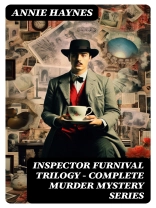The ‘Inspector Furnival Trilogy’ by Annie Haynes encapsulates the essence of early 20th-century detective fiction, weaving together intricate plots that are astutely crafted to engage and enthrall the reader. With vivid characterizations and a distinctive narrative style, Haynes’s writing mirrors the conventions of the Golden Age of Mystery, blending thrilling suspense with astute psychological insights. This complete collection showcases Haynes’s knack for curating atmospheric settings and cleverly unveiling clues, while deftly incorporating social themes of her time, making her work not only entertaining but culturally resonant. Annie Haynes, often hailed as a pioneer of the crime genre, was born in the late 19th century during a time of burgeoning interest in detective narratives. As one of the first female authors to gain widespread recognition in this domain, her experiences navigating a male-dominated literary landscape informed her characterizations of strong and capable protagonists. Haynes’s background as a playwright further honed her skills in dialogue and pacing, enhancing the drama inherent in her novels and captivating her audience. The ‘Inspector Furnival Trilogy’ is highly recommended for aficionados of classic crime literature and modern mystery enthusiasts alike. This collection not only reveals the intricate plots that characterize Haynes’s work but also serves as a crucial insight into the evolution of the detective genre, making it a must-read for anyone interested in the foundations of mystery fiction.
Over de auteur
Annie Haynes (1865 – 1929) was an English novelist known for her works in the detective fiction genre during the ‘Golden Age’ of murder mysteries in the early 20th century. Haynes was a contemporary of esteemed authors like Agatha Christie and Dorothy L. Sayers, although her work is less widely known today. She carved a niche for herself through her Inspector Furnival Trilogy, comprising ‘The Abbey Court Murder’ (1923), ‘The House in Charlton Crescent’ (1926), and ‘The Crow’s Inn Tragedy’ (1927). These novels were celebrated for their intricate plot development and the keen psychological insight Haynes provided into her characters. Haynes broke barriers as a female author in a genre that, at the time, was dominated by male writers. Her literary style often combined suspense with astute social commentary, reflecting the norms and preoccupations of post-Edwardian England. Despite her considerable output—she authored twelve detective novels—Haynes’ work was largely forgotten after her death until recent years, when there has been a resurgence of interest in her novels, akin to the rediscovery of other overlooked female crime writers of her time. Her work, characterized by methodical pacing and tight narrative structures, continues to be an insightful window into the murder mystery canon of the Interwar period.












